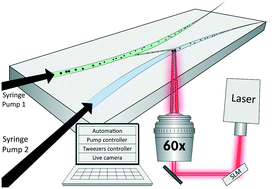Inside the ensemble: unlocking the potential of one-at-a-time experiments with lab-on-a-chip automation†
Abstract
The advent of technologies that allow the interactions of individual microscopic particles to be probed “one-at-a-time” has paved the way for new experimental avenues of enquiry in colloidal systems. For example, investigating whether a particular pair of colloidal particles isolated from a macroscopic sample might adhere to each other when brought into close proximity is certainly possible. However, given the probabilistic nature of the process (different particles within the ensemble may have slightly different surface charge distributions and asperities, and interaction energies involved can be close to thermal values), it is important that many hundreds or thousands of pairs of particles are tested under each set of experimental conditions of interest. Currently it is still an arduous task to perform such an experiment a sufficient number of times in order to acquire a data-set that truly represents the ensemble. Herein an automated particle collider for measuring particle–particle interactions has been realized by combining elements of microfluidics, holographic optical tweezers and image processing. Each individual measurement consists of confining two particles within a predetermined chemical micro-environment, and observing whether their interactions lead to aggregation. To automate the measurements, computer software consisting of LabVIEW and Red Tweezers with a custom plugin was used. Preliminary experiments carried out using 1 μm diameter polystyrene particles demonstrated that many hundreds of pairwise-interaction measurements could be carried out autonomously within a matter of hours. Further exemplar real-world experiments, designed to examine the stickiness of emulsion drops as a function of bulk measurements of the ζ-potential (zeta potential) of the sample, were then performed. It is envisaged that such robust approaches to the automation of “one-at-a-time” experiments will find applications in a large number of areas, and enable previously unthinkable experiments to be carried out in a timely fashion, thus allowing the focus to shift away from tedious experimental frustrations to more profound scientific questions.

- This article is part of the themed collection: Lab on a Chip HOT Articles 2021


 Please wait while we load your content...
Please wait while we load your content...